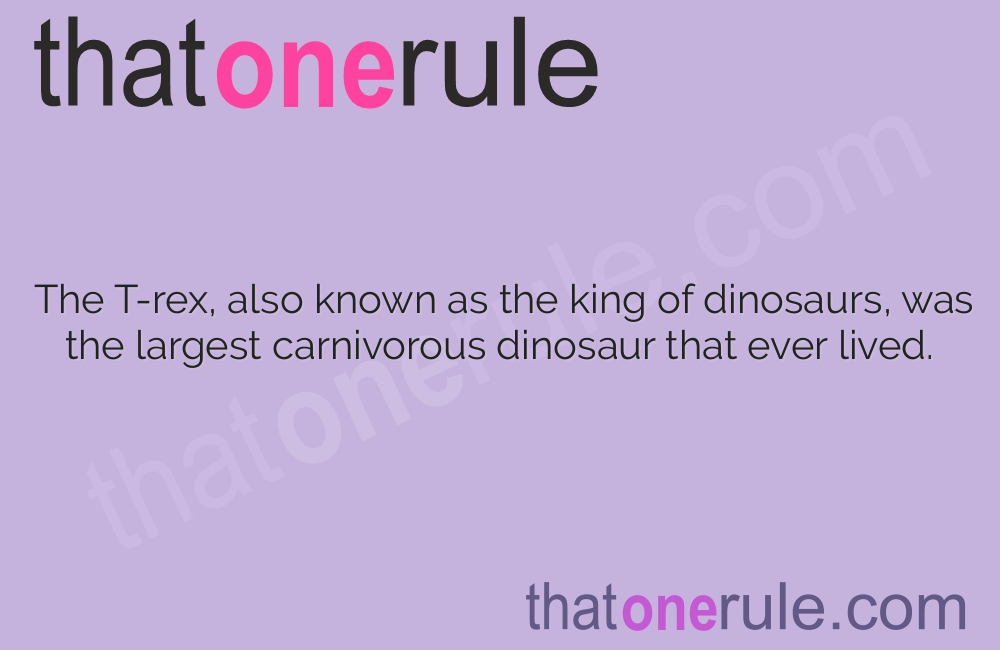

The T-rex, also known as the king of dinosaurs, was the largest carnivorous dinosaur that ever lived.
The T-rex, also known as the king of dinosaurs, was the largest carnivorous dinosaur that ever lived.
T-rex belongs to the theropod group, which means beast-footed dinosaurs.
T-rex walked on two legs, and its powerful hind legs helped it run at speeds of up to 20 miles per hour.
With its massive skull and sharp teeth, the T-rex had one of the most powerful bites of any animal that ever existed.
The T-rex had tiny arms in proportion to its body size, which some scientists still debate the function of.
Despite its small arms, the T-rex had strong and muscular legs that allowed it to tackle its prey.
T-rex had a keen sense of smell, which helped it locate food from long distances.
The T-rex had excellent vision with forward-facing eyes, giving it depth perception and the ability to focus on its prey.
T-rex had a massive tail that helped it maintain balance while running and maneuvering.
The T-rex’s massive jaws contained around 50 to 60 large, sharp teeth.
The bite force of a T-rex was estimated to be around 12,800 pounds, making it one of the strongest of all terrestrial animals.
The T-rex’s name, meaning tyrant lizard king, perfectly describes its intimidating presence.
T-rex existed during the Late Cretaceous Period, around 68 to 66 million years ago.
The exact lifespan of a T-rex is still uncertain, but it is believed to have lived for approximately 20 to 30 years.
T-rex had a long neck, allowing it to reach and tear flesh from its prey easily.
Unlike many other dinosaurs, the T-rex did not have feathers; instead, it had scaly and possibly leathery skin.
T-rex had well-developed olfactory bulbs in its brain, indicating a keen sense of smell.
The T-rex likely had a relatively high body temperature, allowing it to be an active predator.
Recent studies suggest that the T-rex may have been covered in a thin layer of feathers, similar to modern-day birds.
The T-rex is believed to have been an opportunistic scavenger as well as a fierce predator.
T-rex had the ability to crush bones with its strong jaw muscles, ensuring no part of its prey was wasted.
The T-rex’s teeth were constantly replaced throughout its life, similar to sharks.
Some paleontologists propose that the T-rex had feathers on its head, forming a crest or mane.
The T-rex had sharp claws, especially on its hind feet, which were used to immobilize and tear apart its prey.
Some researchers suggest that the T-rex may have been capable of hunting in packs or family groups.
The T-rex’s brain was relatively large and complex compared to other dinosaurs of its time.
T-rex was a unique and iconic dinosaur, representing the epitome of power and strength.
The T-rex’s distinctive roar, as portrayed in movies, is purely speculative since scientists have no definitive way of knowing how it sounded.
The size and power of the T-rex may have been instrumental in shaping the ecosystem of its time.
T-rex would swallow its food in large chunks, using its teeth primarily for cutting and tearing.
The T-rex is estimated to have weighed between 5 and 7 tons, making it one of the heaviest land-based carnivores.
The T-rex’s teeth were sharp banana-shaped as juveniles and became more stout and rounded as they matured.
An adult T-rex could surpass 40 feet in length and stand over 13 feet tall at the hips.
Fossil evidence suggests that the T-rex had a keen sense of hearing, which aided in detecting potential prey or dangers.
While the T-rex is often portrayed as a solitary creature, there is evidence to suggest that they were at least aware of others of their species.
The name T-rex was coined by the paleontologist Henry Fairfield Osborn in 1905 after discovering the first relatively complete skeleton.
The first T-rex fossil was discovered in the Hell Creek Formation in Montana, United States.
The T-rex had a row of serrated teeth, which could inflict massive damage on its victims.
T-rex had a unique feature called a nasal passage that likely helped it vocalize or regulate temperature.
Paleontologists believe that T-rex was an apex predator, meaning it was at the top of the food chain in its ecosystem.
Despite its ferocity, T-rex faced threats from other large predators of its time, such as the Spinosaurus.
Scientists estimate that a mature T-rex needed to consume around 40 to 60 pounds of meat daily to survive.
The arms of a T-rex were relatively weak in comparison to its large body, leading to various speculations about their functions.
Some researchers suggest that the T-rex may have used its arms to help it get up from a lying position or for balance while mating.
The T-rex’s fossils continue to captivate scientists and the general public, providing valuable insights into the prehistoric world they once ruled.
Around the world, coffee enthusiasts enjoy Monin coffee concentrate since it is a multipurpose product. Conveniently combining…
The Importance of Choosing the Right Shower for Your Bathroom Renovating your bathroom can be…
Usain Bolt holds the record for the fastest 100-meter sprint in history.Bolt was named Sportsman…
Love is in the air... and it smells suspiciously like chocolate!Roses are red, violets are…
Life's a beach, take a picture and relax.Sun, sand, and salty kisses. That's what beach…
Hungary is home to the largest thermal water cave system in the world.The Rubik's Cube…